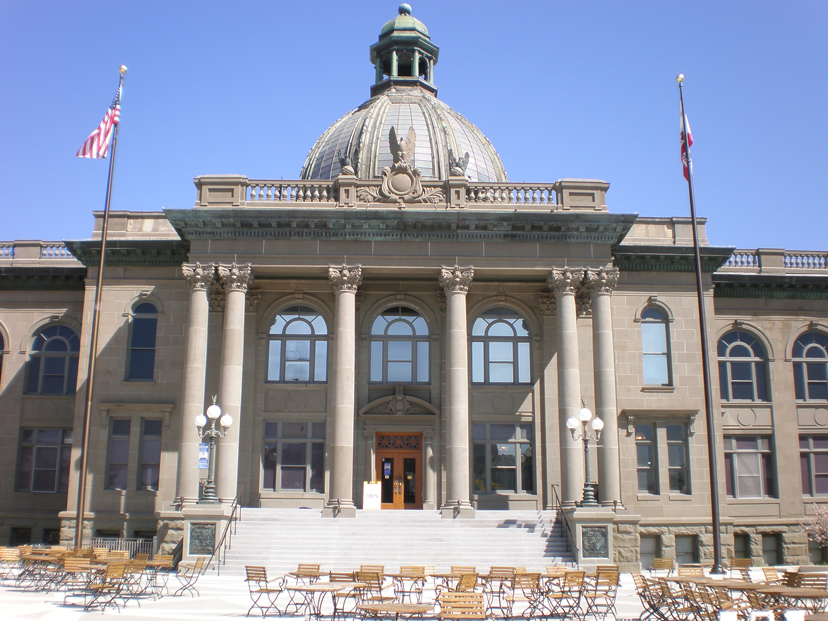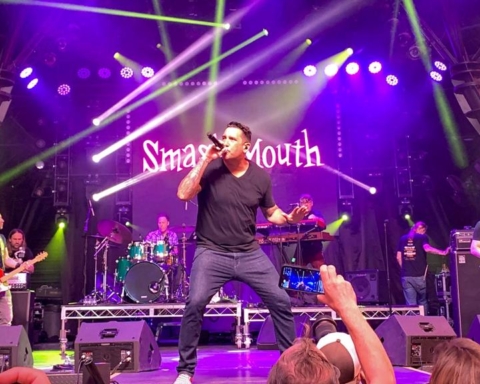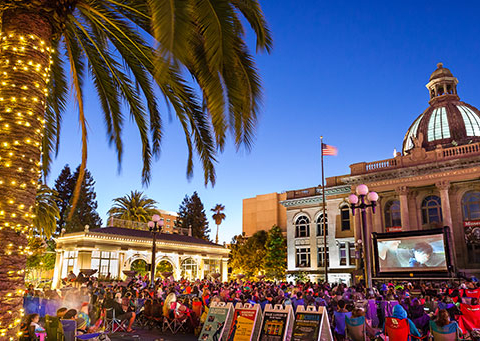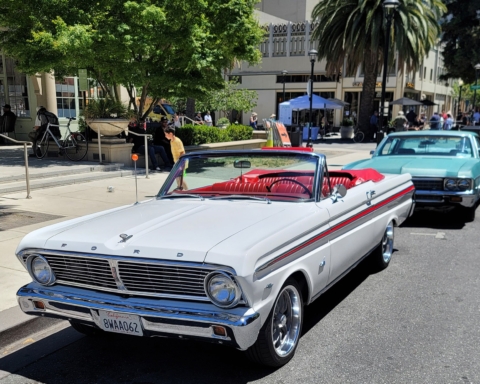By Janet McGovern and Brian Douglas
The history of San Mateo County government in Redwood City has been a bit of a love/hate relationship. The jails, the bail bondsmen, the halfway houses, people complained, arrived courtesy of county government. Sure enough, so did scores of county workers to eat in Redwood City restaurants and shop at stores. On the other hand, when they went home at night, the sidewalks rolled up. But that’s history, really.
Anyone who’s arrived during the last 10 years would have to consult history to learn about “Deadwood City” and the time before the seat of county government emerged as the Peninsula’s entertainment and culture butterfly. And irony of ironies, the Cinderella transformation owes very much to a partnership among county government, the city and its redevelopment agency to repurpose the landmark San Mateo County Courthouse for a history museum fronting on a central plaza.
“I like to think of us as being at Ground Zero for that,” said Mitch Postel, the president of the San Mateo County Historical Association, which runs the museum that occupies the former courthouse. “When we moved in in 1998, it was pretty lazy around here.” He took a walk on a recent Thursday night and was stunned by how crowded downtown was. “We really did play a part to help downtown Redwood City to be as vibrant as it is now…
“In 2019, we will have been open to the public exactly 20 years,” he continues. The history museum was “a very willing and able partner, never questioned the mission and were right there in the corner when the city needed us.”
Built in 1910, after the 1906 earthquake devastated the latest prior courthouse, the spectacular domed edifice faces the Fox Theatre on Broadway, architectural and cultural bookends in a still unfolding story of change, rooted in history.
What to compare the courthouse with? Not much survived after 1906, certainly not major public buildings. There are some splendid private residences, including the Filoli Estate in Woodside and Ralston Hall in Belmont. South San Francisco has a beautiful, though smaller city hall, and San Francisco’s is impressive too but on a much larger scale.
“I can’t think of anything other than the City Hall of San Francisco that can compare,” says Ken Rolandelli, who has long been active in historic preservation in Redwood City. “For a community such as ours to have something that looks like this does is quite a source of pride.” People come from all over to attend concerts on Courthouse Square, he adds, and “Redwood City is really a happening place because of it.”
What a difference a few decades make. Not that long ago, visitors to the old courthouse came to pay traffic tickets and property tax bills or to arm wrestle in Small Claims Court. Today, they’re drawn by concerts, art shows and festivals outdoors and indoors to the museum’s exhibits, research archives, lectures, school tours, Victorian teas, as well as a gift shop that offers discounts during certain events. Museum space is also rented for weddings, receptions, dinners and other private parties. (San Mateo County owns the courthouse, as well as two other offsite historic locations that the historical association operates, Sanchez Adobe in Pacifica and the Woodside Store.)
Almost 40,000 people visited the museum and archives last year, and the other sites and outreach pushes the total to nearly 60,000. Thousands of school kids from all over the tour the museum.
The Day of the Dead celebration held every year on the first Sunday in November brings out more people to the museum than any other event in the year. Now in its eighth year, the “Día de las Muertos” celebration has grown from 500 to more than 3,700 celebrants who toured the old courthouse last year, according to Carmen Blair, the museum’s deputy director. The event is cosponsored with Casa Círculo Cultural, and with the Redwood City Library and the Parks & Art Foundation.
This year’s celebration will be on Nov. 4 and will begin with a procession down Broadway to Courthouse Square, where food purveyors and vendor booths will be set up. Music and dancing add to the festivities as well as a chalk mural. Then from 5 p.m. to 8:30 p.m., the courthouse will be open for children to do crafts in the rotunda while other visitors can see a display of altars in the ceremonial Courtroom A; the altars will remain on display for the following week.
Former Redwood City Mayor Barbara Pierce has just completed a term as chairwoman of the historical association board. The city, she notes, has a large population of families from Mexico and the event “really helps to bring a whole new set of people to the museum and to downtown who might not otherwise.” The high-quality celebration “really honors their tradition,” Pierce says, adding that last year, 2,000 people came through the museum in two hours.
Originally affiliated with what was then called San Mateo Junior College, the historical association got its start in 1935 and created a local history “museum room” in 1941. It moved around within the downtown San Mateo campus until a 6,000-square-foot space was created in 1959 in the new College of San Mateo campus overlooking the city.
By the late 1990s, meanwhile, use of the historic courthouse for trials was winding down. In 1939, a space called “the Fiscal Building” had been added to the front of the building for an expanded office workforce and the stately columns were torn down. An addition to the rear of the structure on Marshall Street was built in 1941. But with the post-World War II growth of county government, more office space was needed and the eight-story Hall of Justice was built in 1963, followed through the years by additional county buildings and a new campus on Tower Road in San Mateo.
In 1998, the museum moved to the old courthouse in Redwood City. That was the good news. The bad news was that the annex buildings were still occupied by county office workers, which meant that the entrance to the museum was not through the front door facing Broadway, but through a side door on Hamilton Street.
The needs of the museum and the renaissance of downtown converged to create what led to the restoration of the historic courthouse, a revitalized museum and a great public plaza. However, making those pieces come together took a lot of heavy lifting by dedicated people.
Rolandelli was part of a committee that was formed to restore the courthouse to its original splendor and create a public plaza that would replace a lawn and simple pathway. The task was daunting enough: relocate the county employees along with removing the three-story Fiscal Building without damaging the historic courthouse structure. Then faithfully reproduce the original columns, façade and wide stairway from photo archives and create a plaza that was contemporary yet would complement the classic courthouse architecture.
Fundraising for the restoration project had its own challenges, especially after the dot.com stock market bubble burst, but between funds from redevelopment, foundations and passing the hat, the finances worked. An unforeseen problem originated in Sacramento, where the head of the state architect’s office was an enthusiast for works that President Franklin Roosevelt’s Works Progress Administration had created. That presented an obstacle to dismantling the Fiscal Building.
As a compromise, the committee agreed to save a fresco in the front lobby that had an historic Art Deco image. Rolandelli and other committee members agree that for Redwood City and San Mateo County, that was a battle well worth winning. In 2005, work began to demolish the Fiscal Building, restore the original courthouse façade and construct the plaza. The following year, the city celebrated the opening of Courthouse Square.
That’s not to say the Fiscal Building didn’t have its good points or its fans. Rolandelli recalls that Jean Cloud, another pioneer in historic preservation efforts, “didn’t want to see it come down.” The WPA structure “was actually quite nice. It’s just unfortunate that they stuck it in front of the courthouse. … The overriding factor was that (the removal in 2005) was going to uncover the historic gem behind it.”
Not only did the demolition open the entrance to the courthouse, it allowed for the creation of Courthouse Square, where events take place almost year-round ranging from concerts to a salsa festival and from an Oktoberfest to corporate events. On most Tuesday evenings, the Redwood City Improvement Association lights up the courthouse exterior with a changing 3D light show.
Working in collaboration, city and county governments invested about $20 million in restoring the landmark courthouse for the museum, including seismic repairs and upgrades to the structure and to the stunning stained-glass domes in the atrium and in Courtroom A. The county continues to maintain the structure and currently has crews working to restore the deteriorating sandstone exterior walls. The museum gets an annual $200,000 subvention from the county, which also provides electricity, gas and water services.
Museum officials take justifiable pride in the fact that it has been accredited since 1972 by the American Alliance of Museums. Accreditors go “measure everything about you,” Postel says, from financial reports, governance, standards of exhibitions, care of the collections, compliance with rules for nonprofits and more.
“It’s not easy to get accredited,” he adds. “There are about 40,000 museums in America and only about 1,000 are actually accredited. It’s so rigorous that a lot of museums don’t go through it.” During the transition from CSM to downtown, it wasn’t easy, he recalls with a laugh. “It was a horrible time to be reaccredited. We were still cleaning up all the dirt from construction. We moved in too soon. One of the things you have to do if you are a museum is you have to be really clean.” But accreditors knew “we were really trying,” he says.
A 2011 report by the AAM’s visiting accrediting committee offered high praise for the historical association for maintaining “a commitment to high standards during a period of unprecedented growth and change for the organization.” A reviewer was struck by “the spirit and drive of the staff” and board members seemed actively engaged, focused on the future and results-oriented. One of the “inspiring” highlights for the visitors was meeting leaders of the active and committed volunteers, including docents and people who raise funds at a used bookstore.
The reviewers also took note of the fact that the majority of the budget comes from private contributions and earned income, and comparatively little from public funds, a validation of the level of commitment from the board and support from the community. Of the total 2018-19 $1,588,500 budget, about $550,000 comes from the annual campaign and corporate and foundation support and another $200,000 from the annual San Mateo County History Makers dinner.
Where some small museums “get a bit too bogged down in the minutiae of little stuff,” Postel says, “I think we do a better job than most history museums in putting our story in context of the larger themes of Western and American history.” In planning the exhibit space, care was taken to show the county as a microcosm in a larger narrative – the story of native Californians, the impact of the missions, immigration and so on – as well as what in San Mateo County history is unique.
Caltrain, for example, operates on a rail corridor that dates back to 1863-64 and was the first commuter railroad west of the Mississippi. The first bit of highway constructed for the automobile was built between San Bruno and Burlingame, according to Postel. Then, of course, there’s the story of Silicon Valley and the entrepreneurs who pioneered in electronics, biotechnology, internet and other leading-edge endeavors.
Many displays include interactive aids to provide more depth as well as hands-on involvement. Young visitors to the Journey to Work gallery are encouraged to ride in a stagecoach, weigh gold, send a telegram and drive a streetcar. Nearly every gallery includes tangible material to recreate an historic experience. Visitors can experience what it took to pack a person’s worldly possessions in a shipping trunk. Or choose to interconnect stones just as workers had done to build the Crystal Springs Dam.
The county’s shipping legacy is celebrated in the Charles Parsons’ Ships of the World exhibit where remarkable ship models he made are displayed. (A fun fact: The San Carlos was the first ship to sail into San Francisco Bay.) The gallery also presents murals and artifacts of some of the great sailing ships that wrecked on the county’s rugged coast along with the original Fresnel lens from the Montara Lighthouse that later helped sailors avoid disaster. The museum also celebrates Redwood City’s legacy as San Francisco Bay’s deep-water port, the port’s importance to the city’s growth and its continued contribution to commerce.
From the beginning, immigration has played a major role in the county’s development and that dynamic is celebrated in the Land of Opportunity exhibit where people from all parts of the world have made the Peninsula one of the most culturally rich in the nation. Colorful costumes of early settlers present a striking display.
Silicon Valley technology has been a dominant economic force in the county and the History Makers exhibit takes a tour through recent history and showcases the entrepreneurs and other business people who made a major impact. On one of the exhibit’s walls, a static mural timeline of entrepreneurs will soon be replaced with two large flat screens to bring contemporary, dynamic life to that space.
One of the newest exhibits celebrates the county’s fame in the surfing community. No, not just web surfing, but riding the giant waves at Mavericks Beach, just north of Half Moon Bay. Visitors start by stepping on a surfboard near a big window overlooking the plaza and Fox Theatre. From this perch, it’s possible to imagine that this 40-foot perspective is what Mavericks surfers experience when they begin their amazing descent. Then one can take a few steps into a high-tech surfing interactive display, mount a surfboard and choose a wave to ride.
A large video screen interacts with foot manipulations on the board to negotiate down a selection of waves, safely make it through a passage with rocks on either side and dismount. The virtual experience lets visitors test surfing skills without getting wet.
Courtroom A is a destination for museum visitors as well as a popular space for special events. Like the domed rotunda, this large courtroom was restored to its 1910 origins. Superior Court Judge George Buck, whose portrait hangs on the wall, presided there until 1932. In fact, cases were heard in the historic courtroom until 1998.
District Attorney Steve Wagstaffe’s roots are deeply connected to downtown Redwood City and its courts. His father had considered going to work for a big law firm in San Francisco but a judge in the historic courthouse urged him to practice law in San Mateo County. He did — for five decades. Steve began his career at the DA’s office in 1975 when it was located in the old courthouse and he was sworn in as district attorney in Courtroom A.
The famous courtroom is still used for ceremonial events such as swearing in new judges. During most regular museum hours, visitors can sit at the bench, named in honor of retired Supreme Court Justice Sandra Day O’Connor who worked in the county’s district attorney’s office after graduating from Stanford Law School in the early 1950s.
“The museum has grown over the years just like Redwood City has grown,” Pierce says, “and it just keeps getting better and better. And there are wonderful plans for the future.”
Lathrop House, one of the Peninsula’s oldest mansions, built in 1863 by Benjamin Lathrop, San Mateo County’s first clerk, will be carefully moved to the back of the courthouse where Hamilton and Marshall streets intersect. The house currently sits on land on Hamilton Street opposite the Hall of Justice, where the county has plans for constructing offices and a plaza. The historic house was last moved in 1905 from Broadway, where the Fox Theatre now sits. Back then, the movers placed logs under the structure and pulled the big house with horses.
Redwood City resident Dee Eva, a member of the historical association board who has been involved with the plans for the relocated Lathrop House, says a company which specializes in historic properties will be handling the transportation job.
“It’s a clear shot,” she says. “They will pick it up, move it forward onto the street, then they are going to pull it down the street in the same orientation a couple hundred feet across Marshall Street and then just back it up and put it on the lot.” The interior furnishings have been removed and stored in containers for the moving date, which has slipped several times. A new foundation and utility work still need to be done before Lathrop House can move to its new home behind the museum.
Rolandelli had had his doubts about how moving the house might affect its listing on the National Register of Historic Places. But at a meeting in May in Palo Alto, the state Historic Resources Commission said the status would be unimpaired, which took care of that concern.
Eva, who has been advocating for a Redwood City history museum for several years, says two interior walls will be taken down to create space for a gallery where city memorabilia and artifacts can be exhibited. Realtor John Shroyer, who has a collection of bottles and ephemera, will provide the first display. She and Pierce say the move should prove beneficial because Lathrop House will be open more often because of the connection with the museum.
“I think it’s the crown jewel of Redwood City historic properties,” Eva says. The house will be illuminated in such a way that it will look dramatic and “really shine.”
According to Eva and Historical Association President Postel, plans are also in the works for a new carriage house to showcase the 30 mostly Brewster era (1810 to 1905) carriages that have been stored in the museum’s 5,000-square-foot warehouse. The carriages that came to the museum once belonged to Lurline Matson Roth, who owned the Filoli Estate. Plans call for a two-story structure next to Lathrop House at the corner of Marshall Street and Middlefield Road. The proposed design would create an open-air rooftop space that could be used for gatherings such as small weddings, parties and corporate events. Postel says many private collectors own carriages and vehicles that could be displayed too.
More immediately, there are plans to have a natural history gallery and redo the immigrants and entrepreneurs galleries, he adds. After 34 years on the job, Postel says his enthusiasm is undiminished. “I am having so much fun,” he says. “It’s great to work here, just with a terrific staff and the volunteers have always been the best group of volunteers.”
Ready to make some more history.






